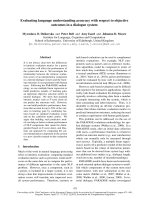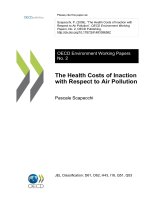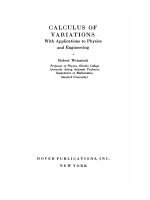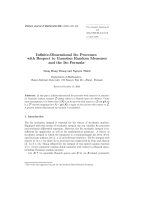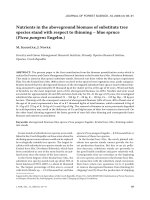Training needs of farmers with respect to new agricultural practices
Bạn đang xem bản rút gọn của tài liệu. Xem và tải ngay bản đầy đủ của tài liệu tại đây (187.37 KB, 6 trang )
Int.J.Curr.Microbiol.App.Sci (2018) 7(11): 577-582
International Journal of Current Microbiology and Applied Sciences
ISSN: 2319-7706 Volume 7 Number 11 (2018)
Journal homepage:
Original Research Article
/>
Training Needs of Farmers With Respect to New Agricultural Practices
H.C. Chhodavadia1, N.S. Joshi2*, V.S. Parmar2, M.L. Patel2 and P.J. Prajapati2
1
Directorate of extension education, JAU, Junagadh, India
2
Krishi Vigyan Kendra, JAU, Amreli, India
*Corresponding author
ABSTRACT
Keywords
Training needs,
Pesticides, Fertilizers,
Seeds, New agricultural
practices
Article Info
Accepted:
07 October 2018
Available Online:
10 November 2018
The present study was conducted in Krishi Vigyan Kendras operational area of Amreli
district. Out of 11 talukas, 5 talukas selected randomly. Out of 5 selected talukas, 2
villages will be selected from each taluka randomly 5 villages selected. Among selected
villages, 10 Farmers from each village were selected for the study. Thus, total 100
respondents were selected for this study. Study revealed that majority of the respondents
training needs related to fertilizers is vermi composting and in case of seeds, improved
varieties and hybrids of different crops, related to pesticides it was control of disease and
insect by proper pesticides and lastly, regarding farm machinery and implements it was
getting subsidy and loan.
Thus for making training more effective, it
should be based on farmers felt needs.
Introduction
In Saurashtra region the Amreli is agriculturedominated district. About 80 % of population
is engaged in agriculture and allied activities.
The Amreli district offers good scope for
Agricultural
development.
Agricultural
Production potential depends mostly on the
management practices. These practices vary
significantly across various agro-ecological
regions due to many factors.
Decision making process on farm matter,
perform many of the farm operations and
undertake many responsibilities concerning
management of farm activity. Agricultural
activities are the main areas of the economic
activities for rural area.
The training programme which is not need
based may have a little impact on bring
desired change in the clientele system.
Keeping this fact in view, the future study of
training needs of farmer with respect to new
agricultural production practices in Amreli
district of Saurashtra region of Gujarat State
will be undertaken with following specific
objective.
To study the training needs of the farmers with
respect to New Agricultural practices related
to fertilizers, seed, pesticide, machinery and
implement.
577
Int.J.Curr.Microbiol.App.Sci (2018) 7(11): 577-582
Materials and Methods
The study was beining conducted in Krishi
Vigyan Kendras operational area of Amreli
district. Out of 11 talukas, 5 talukas viz.,
Amreli, Bagasara, Savarkundla, Rajula and
babara selected randomly. Out of 5 selected
talukas, 2 villages will be selected from each
taluka randomly viz., Champathal, babapur,
Mandavda, samadhiyala, gadhakda, likhala,
agariya, Katar, Charkha, bambhaniya. Among
selected villages, 10 Farmers from each
village were selected for the study. Thus, total
100 respondents were selected for this study.
The questionnaire was prepared in local
language in accordance with the objectives.
Training needs of the farmers were assessed
under five sub heads which include training
needs related to fertilizers, Seed, Pesticides,
farm machinery and implements and animal
feed and chemicals. The training needs were
assessed by ranking them according to
immediate necessities felt by farmer and
scoring of 3, 2 and 1 was given to the items
most needed, somewhat needed and not
needed respectively. Firstly, the total training
need score of a particular item was calculated
considering the responses expressed by all the
respondents. Secondly, the mean score of a
particular item was worked out by dividing the
total score of their particular item with the
total number of respondents. Finally, based on
the mean score, the rank order of preference
for training in a particular area was found out.
Results and Discussion
Training needs of the farmers with respect
to New Agricultural practices
An attempt was made to know the training
needs by respondents and frequency and
percentage for each training needs were
calculated. Then they were ranked and
presented in Table 1.
The data presented in Table 1 observed that
most important training need of farmers
related to fertilizers is vermi composting
(2.64) and ranked first which in conformity
with Singh et al., (2006) who revealed that
majority of the respondents expressed training
needs for methods of vermin compost making.
Further, fertigation (2.60) and micro nutrients
fertilizers was ranked second by the
respondents. Moreover, respondents had given
preference to Nutrient contents in fertilizers
(2.53), Methods of fertilizer application and
Methods of fertilizer application (2.44),
Composting (2.42), Methods of nitrogenous
fertilizer application (2.40), Soil testing for
fertilizer application (2.26), Bio-fertilizers
(2.22), Type of fertilizers (2.15), Cake
fertilizers (2.12), Implements used for
fertilizer application (1.94), Go-down
construction (1.88), Fertilizer doses for crops
(1.83), Fertilizer store (1.63) which were
ranked at III, IV, V, VI, VII,VII, VIII, IX, X,
XI, XII, XIII, XIV. This finding are supported
with Lego et al., (2018), Bassim, (2016),
Waghmode et al., (2014) and Prashanth et al.,
(2013).
Ranks reflected that respondents interests
towards organic farming and efficient use of
farm residues so they are very interested
towards vermi-composting. Apart from that
they have also need interested on fertigation
technology and micro nutrients fertilizers In
addition, respondents had very much
preference to trainings needs regarding
nutrient content in fertilizers and INM and
methods of fertilizer application showing
farmers interest in economic and efficient use
of fertilizers. Later on, ranks show
respondents may have some knowledge about
these aspects and hence score are low.
The data presented in Table 2 indicated that
improved varieties and hybrids of different
crops (2.63) was given as most pressed areas
578
Int.J.Curr.Microbiol.App.Sci (2018) 7(11): 577-582
of training need by respondents followed by
seed treatment (2.56), type of seeds (2.56),
Certified seeds (2.50), Ideal seed storage
(2.46), germination power of seeds of different
crop (2.45), Fumigation to seeds (2.23),
Cultivation of hybrids of different crops
(2.16), Viability of seeds of different crops
(2.15) and hence ranked II, III, IV, V, VI,
VII,VII, VIII and IX respectively. This finding
is supported with Lego et al., (2018), Bassim,
(2016) and Waghmode et al., (2014).
Ranks showed that respondents are very
curious to know about what kinds of variety
him or her cultivated, can they used it in next
year or not etc. Moreover, need of training
about seed treatment indicated that
respondents awareness regarding soil borne
diseases or may be the area have problem of
this kinds of soil borne diseases. It is very
interested and good for agricultural point of
view that respondent’s need of training area
were type of seeds and certified seeds also.
Table.1 Training needs of the respondents with respect to New Agricultural
Practices related to Fertilizer
Vermin-composting
Most
Needed
70
n=100
Somewhat Not
Total Mean Rank
Needed
Needed
Score
24
6
100
2.64
I
Fertigation
69
22
9
100
2.60
II
Micro-nutrients fertilizers
63
34
3
100
2.60
II
Nutrient contents in fertilizers
57
39
4
100
2.53
III
nutrient 56
32
12
100
2.44
IV
fertilizer 51
42
7
100
2.44
IV
64
14
22
100
2.42
V
Methods
of
nitrogenous 49
fertilizer application
Soil testing for fertilizer 47
application
32
Bio-fertilizers
42
9
100
2.40
VI
32
21
100
2.26
VII
58
10
100
2.22
VIII
Type of fertilizers
23
69
8
100
2.15
IX
Cake fertilizers
30
52
18
100
2.12
X
Implements used for fertilizer 20
application
23
Go-down construction
54
26
100
1.94
XI
42
35
100
1.88
XII
Fertilizer doses for crops
31
21
48
100
1.83
XIII
Fertilizer store
16
31
53
100
1.63
XIV
Training needs
Integrated
management
Methods
of
application
Composting
579
Int.J.Curr.Microbiol.App.Sci (2018) 7(11): 577-582
Table.2 Training needs of the respondents with respect to New Agricultural
Practices Related to Seed
n=100
Training needs
Most
Somewhat Not
Total Mean Rank
Needed Needed
Needed
Score
19
9
100
Improved varieties and hybrids of different 72
2.63
I
crops
70
16
14
100
Seed treatment
2.56
II
65
21
14
100
Type of seeds
2.51
III
64
22
14
100
2.50
IV
Certified seeds
56
34
10
100
2.46
V
Ideal seed storage
58
29
13
100
2.45
VI
Germination power of seeds of different crop
38
47
15
100
2.23
VII
Fumigation to seeds
24
68
8
100
2.16
VIII
Cultivation of hybrids of different crops
42
31
27
100
2.15
IX
Viability of seeds of different crops
Table.3 Training needs of the respondents with respect to New Agricultural
Practices related to pesticides
Training needs
Most
Needed
Control of disease and insect by proper 76
pesticides
72
Type of pesticides
69
Protection of the stored seeds from pest
Preparation of solution of pesticides for 70
spraying
Protective measures and treatment over 61
poisoning
48
Methods of proper spraying and dusting
46
Types of improved sprayers and dusters
38
Disposal of empty bottles and containers
n=100
Somewhat Not
Total Score Rank
Needed
Needed
24
0
100
2.76
I
24
24
21
4
7
9
100
100
100
2.68
2.62
2.61
II
III
IV
27
12
100
2.49
V
31
28
26
21
26
36
100
100
100
2.27
2.20
2.02
VI
VII
VIII
Table.4 Training needs of the respondents with respect to New Agricultural practices related to
related to machinery and implements
n=100
Training needs
Most
Somewhat Not
Total Means Rank
Needed Needed
Needed
Score
72
22
6
100
Regarding getting subsidy and loan
2.66
I
45
32
23
100
Repairing of machinery and implements
2.22
II
46
29
25
100
221
III
Purchasing of machinery and implements
42
29
29
100
213
IV
Operating of machinery and implements
7
15
78
100
129
V
Regarding driving
580
Int.J.Curr.Microbiol.App.Sci (2018) 7(11): 577-582
The data presented in Table 3 observed that
control of disease and insect by proper
pesticides (2.76) was most needful training
need and got first ranked followed by Types
of pesticides (2.68), Protection of the stored
seeds from pest (2.62), Preparation of solution
of pesticides for spraying (2.61), Protective
measures and treatment over poisoning (2.49),
Methods of proper spraying and dusting
(2.27), Types of improved sprayers and
dusters(2.20), Disposal of empty bottles and
containers (2.02) which ranked II, III, IV, V,
VI, VII, and VIII respectively. This finding is
supported with Lego et al., (2018), Bassim,
(2016), Pandey et al., (2015), Punitha, et al.,
2012 and Sarda and Gill (2005).
solution of pesticides for spraying and lastly,
regarding farm machinery and implements it
was getting subsidy and loan, repairing of
machinery and implements, purchasing of
machinery and implements.
References
Bassim, K. 2016. Training Needs of Rice
Farmers in Mahanawiyah District, ALQadisiya Province, Iraq. Turkish
Journal of Agriculture - Food Science
and Technology, 4(12): 1072-1076
Inne Lego, R. Bordoloi, Pankaj Kumar
Meghwal, Rajkumar Josmee Singh and
Ram Singh. 2018. Training Needs
Assessment of Agricultural Extension
Personnel in Arunachal Pradesh, India.
Int.J.Curr.Microbiol.App.Sci.
7(01):
1684-1694.
Pandey, R. K., Doharey, R.K., Singh, R. K.,
Mishra, A. K., Pandey, J., Kumar, M.
and Dwivedi, A. 2015. A Critical
Analysis on Training Needs of Farmers
About Mustard Production Technology.
International Journal of Agriculture
Sciences, 7 (14): 892-895.
Prashanth, P., Jagan Mohan Reddy, M. and
Sreenivasa Rao, I. 2013. Training needs
of cotton farmers on organic cotton
production technologies in Andhra
Pradesh. Agriculture Update, 8(1&2):
14-18.
Punitha, P., Singh, S. B. and Seetharaman, R.
N. 2012. Gender differences on training
needs among farmers' discussion
groups. Indian Research Journal of
Extension Education. 12(1):73-77.
Sarda, M. K. and Gill S. S. 2005. Training
needs of the input dealers on pesticide
application on cotton crop in Punjab.
Management
Extension
Research
Review, 6(1): 63-74.
Singh, J., B. Bhimawat S., and Punjabi N. K.
2006. ‘Constraints and training needs
for adoption of vermiculture technology
It was much cleared from the ranks that
respondent wants to implements proper plant
protection measures in their field.
Regarding farm machinery and implements
data presented in Table 4 revealed that
regarding getting subsidy and loan (2.66)
most needed training followed by repairing of
machinery and implements (2.22), purchasing
of machinery and implements (2.21),
operating of machinery and implements
(2.13), regarding driving (21.29) which
ranked II, III, IV and V respectively. This
finding is supported with Waghmode et al.,
(2014).
In conclusion, training needs of respondents
clearly concluded that majority of the
respondents training needs related to
fertilizers is vermi composting followed by
fertigation and micro nutrients fertilizers,
nutrient contents in fertilizers, methods of
fertilizer application and in case of seeds,
improved varieties and hybrids of different
crops, seed treatment, type of seeds, certified
seeds. Whereas, related to pesticides it was
control of disease and insect by proper
pesticides, types of pesticides, protection of
the stored seeds from pest, preparation of
581
Int.J.Curr.Microbiol.App.Sci (2018) 7(11): 577-582
among the farmers of 'Jhadol panchayat
samiti in Udaypur district of Rajasthan.
Rajasthan Journal Extension Education.
14:124-126.
Waghmode, Y. J., Desai, A. N. and Sawant,
P. A. (2014). Training needs of
agricultural input dealers in transfer of
agriculture technology in Ratnagiri
district of Konkan region. Agriculture
Update, 9(4): 543-546.
How to cite this article:
Chhodavadia, H.C., N.S. Joshi, V.S. Parmar, M.L. Patel and Prajapati, P.J. 2018. Training
Needs of Farmers With Respect to New Agricultural Practices. Int.J.Curr.Microbiol.App.Sci.
7(11): 577-582. doi: />
582


